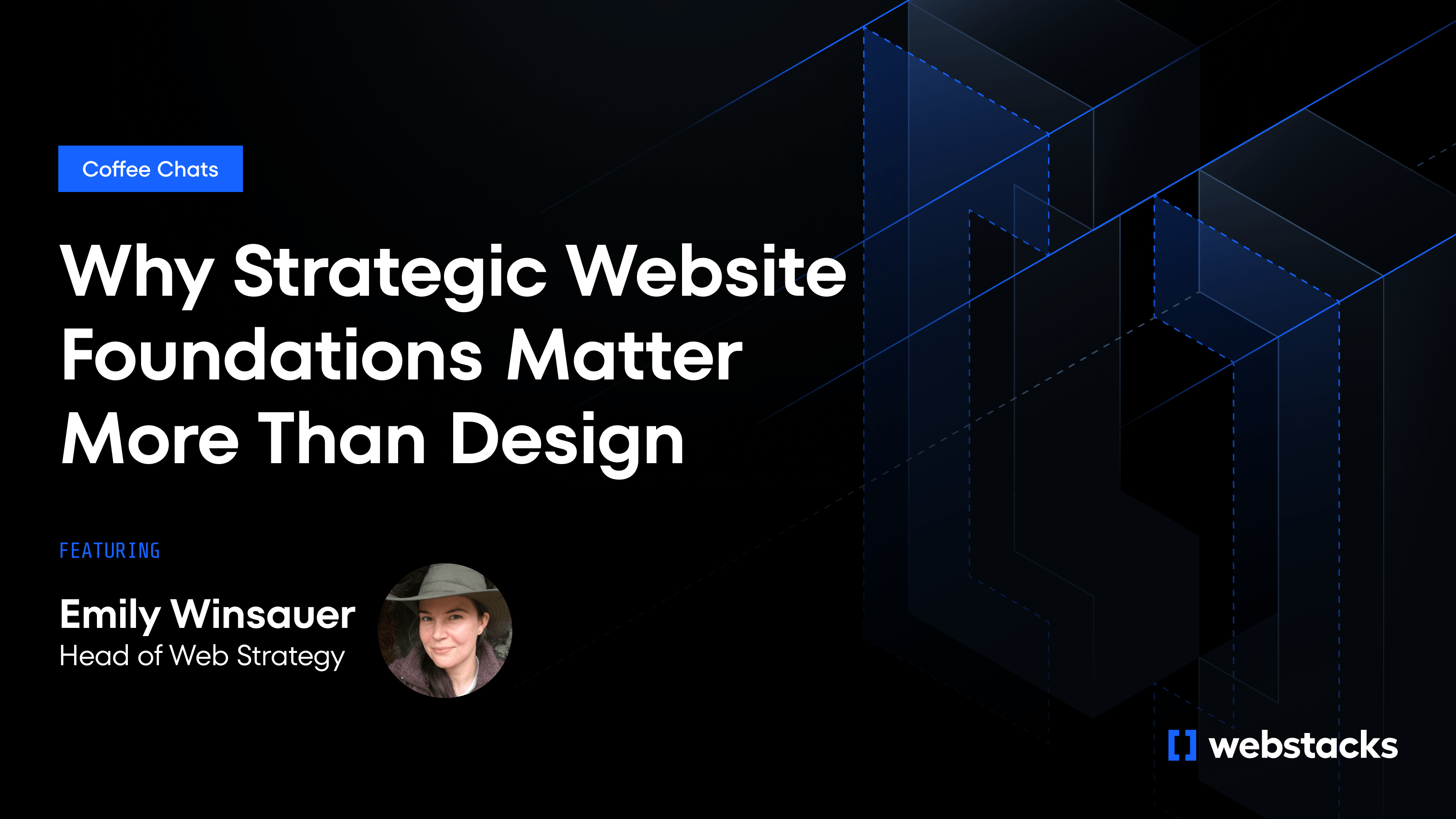You can have the sharpest brand, the best protocol, and a growing community, but if nobody can find you through search, you’re leaving growth on the table.
Too many Web3 teams treat SEO as something to figure out later. But by the time you realize you need it, your competitors are already ranking for the terms that matter, such as staking guides, integration docs, ecosystem updates, and everything in between.
Search is often the first signal of credibility. Investors, developers, and partners are all checking if your site loads fast, explains things clearly, or shows up at all. If it doesn’t, you lose trust.
This guide breaks down what makes Web3 SEO different, from audience intent and content structure to performance benchmarks. It also shows where most teams get stuck, and what it takes to build a system that’s fast, flexible, and built to scale.
At Webstacks, we help Web3 companies launch modular platforms that support SEO from day one—not just pretty sites, but performance-ready systems that grow with your product. You’ll see how that works, with examples from Solana, Circle, Trust Machines, and more.

What Makes SEO for Web3 Different from Traditional SEO
Most SEO guides are written for eCommerce or SaaS teams. But Web3 websites aren’t online stores or sign-up funnels. They’re ecosystems. And that changes everything about how SEO works.
You’re not just optimizing for search engines. You’re educating developers, explaining new protocols, and building credibility across fragmented audiences. And that’s where standard SEO advice falls short.
Different Audiences = Different Search Intent
In Web3, you’re often speaking to:
- Developers looking for SDKs, GitHub repos, and integration guides
- Users searching for wallet support, staking instructions, or how-to content
- Investors and partners checking credibility before they engage
Each group searches differently. One might search “how to wrap BTC,” another “what is a rollup,” and someone else might just be Googling your brand name. Your content needs to meet all of them where they are.
SEO is the First Trust Signal
Search is how people decide if you’re worth their time. When they Google your product and find nothing, or land on a slow, outdated site, it creates doubt. For Web3 orgs, that’s a missed opportunity.
Before anyone connects a wallet or reads your docs, your website is already sending a message. Here's what it needs to say:
- You're credible
- You’re easy to understand
- You’re ready to scale
If your site is slow, confusing, or buried in search results, you're sending the opposite message. Even if the product is solid, it won't feel that way.
Your Content Has to Do More
Most SEO content in Web2 is about comparison pages or bottom-of-funnel keywords. In Web3, content needs to:
- Explain complex systems simply
- Guide users through unfamiliar actions
- Rank for both branded and non-branded terms
- Stand up to scrutiny from a technical audience
That’s why SEO in Web3 focuses on performance, clarity, and trust, not just keywords.
Web3 SEO Starts With Site Performance
Google rewards sites that load fast, feel stable, and deliver a clean experience. And in Web3, where many users are developers, performance matters even more.
A slow site is frustrating and a sign that the underlying tech might not be ready.
Why Performance Impacts SEO and Credibility
Here’s what slow load times really cost you:
- Search visibility: Google uses Core Web Vitals as part of its ranking algorithm
- Engagement: Users bounce if a page takes more than a few seconds to load
- Trust: Developers judge your product based on the speed and structure of your site
- Conversions: If users can’t load your docs or sign up for your product quickly, they won’t come back
What Fast Web3 Sites Are Built With
At Webstacks, we build with speed as a starting point. That means:
- Next.js for fast, dynamic frontends
- Vercel for fast, scalable hosting
- Performance-tuned templates that meet Core Web Vitals by design
You don’t need to trade design or flexibility for speed. We help Web3 teams combine all three from the start.
For example, when Circle came to us, their existing setup couldn’t scale with their growth. We rebuilt key components to improve load times across the site, which helped:
- Reduce bounce rates
- Speed up crawl and indexation by Google
- Create a smoother experience across docs, landing pages, and blogs
That kind of performance boost helps rankings and makes your product easier to trust.
Why SEO Needs More Than a Good-Looking Website
Many Web3 teams launch with a sharp-looking site. But after a few months, it starts slowing them down. Every time marketing wants to update content, fix a meta title, or publish a new landing page, they’re stuck waiting on a developer.
That lag kills SEO momentum.
SEO Needs a Flexible Publishing Workflow
Search optimization requires continuous updates:
- Publishing new blog posts and docs
- Refining internal linking as your product grows
- kmTesting headlines, CTAs, and content formats
- Fixing page speed and structure issues over time
If your site is hard to update, even the best strategy will stall.
What a Scalable SEO System Actually Looks Like
At Webstacks, we design systems that let marketing and growth teams move fast without breaking things. We use:
- A headless CMS like Sanity or Contentful to give marketers publishing control
- Modular components that can be reused across pages for consistency and speed
- Structured information architecture (IA) that supports both users and search engines
- Pre-optimized templates that meet Core Web Vitals and reduce technical debt
This setup gives developers the flexibility they need while removing blockers for content teams.

On-Page SEO for Web3 Products
On-page SEO is where a lot of Web3 teams lose momentum because they overcomplicate it or miss the basics.
Your content should be structured in a way that’s understandable to both users and search engines.
Start With the Pages That Actually Drive Traffic
Start with the pages that drive real traffic.
Your homepage should clearly explain what your product does. Docs are often the first place developers evaluate your stack, so make sure they’re easy to navigate. Product and feature pages need to answer specific use-case questions, while your blog can attract top-of-funnel traffic.
And don’t overlook a glossary or explainer section, as they are great for capturing searches from new users who are still learning the basics.
Each of these pages should follow a clear, repeatable structure to help users scan and Google crawl.
Key On-Page Elements That Still Matter
- Straightforward H1s and subheadings: Tell both users and bots what the page is about
- Page titles and meta descriptions: Match search intent and improve click-through rates
- Alt text and ARIA labels: Help with accessibility and semantic understanding
- Internal linking: Reinforce relationships between your content
- Schema markup: Enhance visibility with rich results in search
These elements directly impact how well your content is indexed and ranked.
Speak to Humans First, Bots Second
Web3 products are often technically complex, but SEO content still has to be clear. That means:
- Explaining concepts like staking, bridges, or rollups in plain English
- Avoiding jargon unless your audience expects it
- Writing answers to real questions your audience is searching for
For example, when Trust Machines launched, they had to explain a multi-layer infrastructure product to a mix of technical and non-technical users. We helped organize their site so each audience could find what they needed—fast. The result was more qualified traffic and stronger engagement from day one.
If people don’t understand your product, they won’t stick around. On-page SEO is how you guide them.
Off-Page SEO That Builds Web3 Credibility
You can build the fastest, cleanest site in your ecosystem, but if nobody links to it, you’re still invisible.
Off-page SEO is what tells search engines (and your audience) that your content is worth paying attention to. And in Web3, trust signals matter more than ever.
Why Off-Page SEO Still Matters in Web3
Backlinks help with:
- Search engine trust: The more credible sites that link to you, the more likely Google is to rank you
- Referral traffic: People click on useful links in dev docs, product tutorials, and community pages
- Community awareness: Backlinks often reflect word-of-mouth from developers, partners, or contributors
Unlike traditional B2B SEO, Web3 projects don’t always get links from press releases or corporate partners. You need a different playbook.
Where Quality Links Come From in Web3
These are the things that drive results:
- Developer platforms: GitHub repos, Stack Overflow answers, and ReadMe integration pages
- Crypto-native media: Mentions on outlets like CoinDesk, Bankless, or Layer 2-focused newsletters
- Community-authored content: Tutorials, ecosystem blogs, and translation projects from advocates
- Social-first signals: X (Twitter) threads, Discord discussions, and cross-posted Mirror articles
- Partner ecosystems: L1 and L2 sites that list or showcase tools in their stack
These links often require collaboration. That’s why strong content and technical documentation is your best asset.
How to Build Content Worth Linking To
The most link-worthy content types include:
- Developer guides and integration walkthroughs
- Glossaries that clarify confusing Web3 terms
- Performance benchmarks or architecture breakdowns
- Technical comparisons or ecosystem maps
If the content is genuinely helpful, people will reference it.
How Webstacks Helps Web3 Teams Win at SEO
Most SEO problems are caused by the wrong setup. You’re trying to scale, but the site is slow, hard to update, or built on a stack that was never meant to support long-term growth.
At Webstacks, we implement SEO into the way your website works from day one:
We Build for Speed and Scalability
The stack matters. We use:
- Next.js for fast frontends
- Vercel for optimized hosting
- Sanity and Contentful for flexible, headless content systems
This combination makes sure your site:
- Loads quickly across devices
- Ranks better in search because it meets performance benchmarksGives marketing teams the freedom to publish without waiting on engineers
We Give Marketers Autonomy Without Compromising Quality
You shouldn’t need to file a ticket every time you want to update a blog post or test a new landing page.
That’s why we design modular components and atomic design systems, so non-technical teams can ship faster, while devs still have control over how things scale.
We Bring It All Together in One System
You need a platform that supports your content, branding, product growth, and SEO goals over time. And that’s what we build.
We’ve done it for fast-moving Web3 teams like Circle, Trust Machines, Solana, and Blocknative, helping them improve performance, scale content, and build SEO systems that don’t break as they grow.
Treat SEO Like a System, Not a Shortcut
SEO is not something you can “turn on” after launch or fix with a few keyword tweaks. It works when your website is fast, your content is clear, and your team has the tools to keep things moving.
In Web3, that means:
- Your docs load fast
- Your landing pages explain value without friction
- Your team can ship content without getting blockedYour product shows up in search before your audience even knows your name
Trying to patch that together later usually leads to one thing: a rebuild. And lost momentum.
At Webstacks, we help Web3 teams avoid that by building the right system from the start. One that supports SEO, content, and product growth—without bottlenecks.
If your current site is slowing you down, we can help fix that. Let’s talk.




